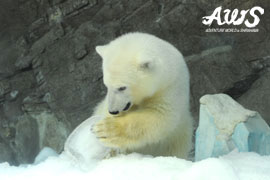Safari&Marine イルカの赤ちゃん誕生と子育て〜繁殖研究の取り組み〜

アドベンチャーワールドでは2010年5月24日、6月15日にバンドウイルカ2頭、カマイルカ1頭、計3頭の赤ちゃんが誕生しました。3頭とも順調に成長しており、親子で暮らす
■イルカの赤ちゃんすくすく成長中■
●バンドウイルカ(2010年5月24日・6月15日生まれ)
5月生まれの赤ちゃんは、生後3ヶ月経つと少しずつ魚をたべるようになってきました。好奇心が旺盛で、母親の真似をしてジャンプをし、うまく出来るとトレーナーに向かって伸び上がってアピールしてくることもあります。バンドウイルカは生後1年半〜2年は母親から授乳しますが、生後3〜4ヶ月頃から餌にも興味を持ち始めます。
ところが6月生まれの赤ちゃんは4ヶ月経っても餌に興味を示さず、母親が餌を食べていても一頭で泳いでいます。このままでは母親のミルクの出る量が減り始めると、栄養が足りず痩せてきてしまいます。そこで10月末、この2組の親子を同じプールで飼育することにしました。同じ大きさ
■バンドウイルカのの繁殖研究■
現在、野生のバンドウイルカは絶滅の恐れが少ない動物ですが、環境破壊が進めばその数が少なくなる可能性があります。一方で全国の動物園、水族館で飼育されて飼育されているイルカのうち、飼育下で生まれた個体はわずかなのです。鯨類の人口哺育が大変難しいことや、敢えて繁殖を制限していることなどが理由にあげられます。しかし、飼育個体数を維持するには、計画的な繁殖が必要です。
当園では2010年10月から神戸大学と共同で「バンドウイルカの精液の保存方法」に関する研究を開始しました。バンドウイルカの精液に適した保存方法を確立し、将来的には人工授精も検討していくのがこの研究の目的です。当園ではバンドウイルカに麻酔をかけずに精液採取が出来るように、トレーニングを行っています。その結果ストレスを最小限に抑えて、定期的に精液を採取することが出来ます。バンドウイルカでの保存方法が確立出来れば、他の鯨類に応用出来る可能性もあります。
鯨類の繁殖、「種の保存」に少しでも貢献出来るよう、これからも積極的な活動を行っていきます。
(前園 優子)

